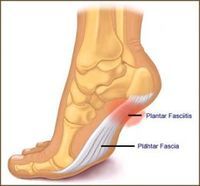
Planters fasciitis is caused by a tear or a break in the tendons that hold the planter to the base of the plant. Most people that have planter fasciitis have sharp pain when they first move their arms or legs during the early morning or late afternoon.
As you start moving your arms and legs, the sharp pain usually decreases. However, as the day progresses, you will notice that the pain becomes worse. It can be particularly painful when you are standing for quite some time. This can often become a real problem when it's raining or very cold outside. You may even find it hard to move around because of the pain.
If you do not treat planter fasciitis immediately, it can progress to other parts of the plant and affect the tender leaves. You may also experience an infection of the plant itself. The infection may spread to other parts of the plant and make the condition worse. If you have a high-traffic area, such as a lawn or in your garden, you should seek medical attention for this condition as soon as possible.
In most cases, your doctor will advise you to seek medical attention if the condition has continued for at least six weeks. It can be difficult to diagnose and treat planters fasciitis if it has progressed to other parts of the plant. Therefore, many people will choose to treat it naturally. Here are some tips to help you deal with this condition.
One of the best ways to treat plantar fasciitis is to reduce the amount of time that you stand on your planter. By doing so, the stress on the tendons that hold the plant together will be reduced. In addition, standing in the sun and applying heat may aggravate the situation. You should also be careful to not bend down when standing or walking on your planter. You may find that walking on hard ground will cause pain in the planter. You can avoid this by using a step stool to stand on.
When walking through the grass or trying to maneuver your planter, you should make sure that your feet are pointed directly towards the soil. and not off to the side. You should avoid bending or tipping your planter to the side too much. By positioning your feet correctly, the tendons will be kept together and the plant will remain strong and will not break.

You should also keep a supply of water and a hose close at hand so that you can apply hot water to the area if necessary
A garden hose can apply more than enough water to the affected area. If the area is particularly cold, you can turn on a faucet of water to give the plant a little bit of warmth. Hot water helps to moisturize the plant and to help the tendons heal faster.
The moisture that is lost through the application of water from the hose is another way to remedy planter fasciitis. In most cases, when standing in the same place for too long, the plants will start to dry up. It is important to keep water on the plant at all times to keep them hydrated. If the plant dries out completely, it may be necessary to water the area again to help it regain its strength.
If the plant begins to wilt, you may have to replant it. Be sure to wear protective gear such as a hard hat, protective gloves and long sleeves in order to keep yourself from coming into contact with the plant.
If you notice that the plant is becoming limp or wilting, you can prune it with scissors. It is also important to remember to take care of any infected leaves that are growing and watering them properly. If you notice that the plant has a thick green coat of leaves, you can cut it back slightly so that it will start growing quickly again.
Although these are just a few tips for treatment, you should always follow the above steps if possible. Even though the condition may seem frustrating, over time it will become easier to keep the plant healthy and continue to bloom.